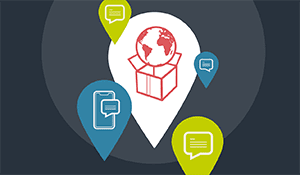
Cross-border ecommerce has never been more attractive than it is right now. When the web is your department store, it doesn’t really matter where an online store is based – everyone with an internet connection is a potential customer. And more people than ever are taking up the offer, to the point where eMarketer predicts the value of global ecommerce will reach $5 trillion by 2021.
The cross-border opportunity might be alluring, but it’s not without its drawbacks. International customers are lucrative, but they can also be difficult to reach, especially if retailers lack a physical presence in the local area.
Think global, act local
If you think customers will relax their standards when shopping with overseas brands, you’re mistaken. They expect just as much from the brand located 500 miles away as they do from the one that’s 5 miles down the road. That means fast, free and trackable delivery, no matter where their order is coming from. According to our analysis [>> campaign link], 15% said they would shop more internationally if they had multiple delivery options.
Retailers looking to expand across borders must ensure they offer a delivery proposition to compete with domestic players, including a range of fulfillment options to suit preferences in that particular geographical market.
Grow your regional presence practically
One key barrier to international expansion that retailers must contend with is the logical complications of offering tailored delivery propositions wherever they operate, especially when shipping landscapes can vary substantially across regions. Indeed, our analysis found that 28% of consumers say slow delivery puts them off overseas brands.
However, retailers can fast-track their cross-border expansion by tapping into existing third-party shipping networks with a wide range of shipping services in your target markets. This partner should ideally have global coverage, to support new market entries further down the track, as well as a detailed knowledge of local regulatory requirements.
Flex your global supply chain
The secret to successful international expansion lies in finding the right balance between cost and customer experience, and the capability to adjust this equation as your business grows and matures.
Building this level of agility and scalability into your supply chain requires a certain amount of automation. Delivery Management Software is a great opportunity to build efficiency into tasks like carrier allocation or customs documentation on a global scale. Software solutions can also help retailers harness the power of data to assess their success in new markets and plan their next move with intelligence.
The good news is, it’s possible to enter new geographical markets without compromising your customer experience – or your bottom line. This is possible now and into the future. The secret lies in building an ecosystem of partners and technology that allows you to expand with agility, but also with practicality.
Find out more about the steps the world’s leading retailers are taking now to seize the cross-border opportunity – download our International eCommerce Expansion Playbook

